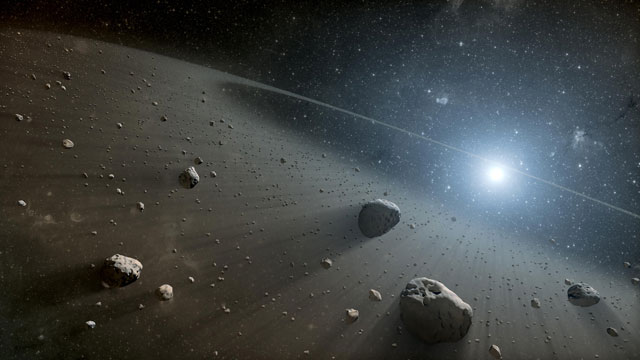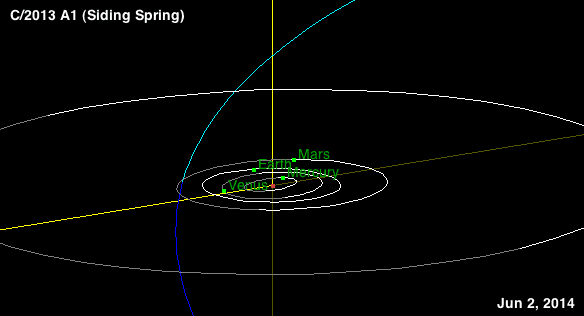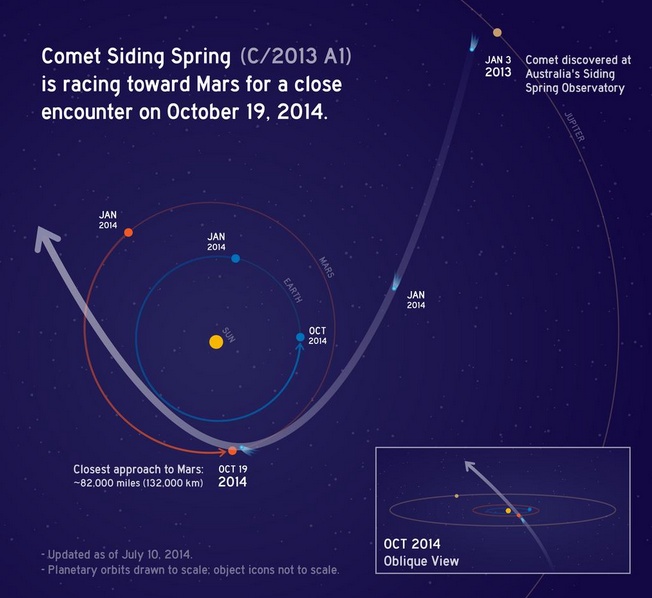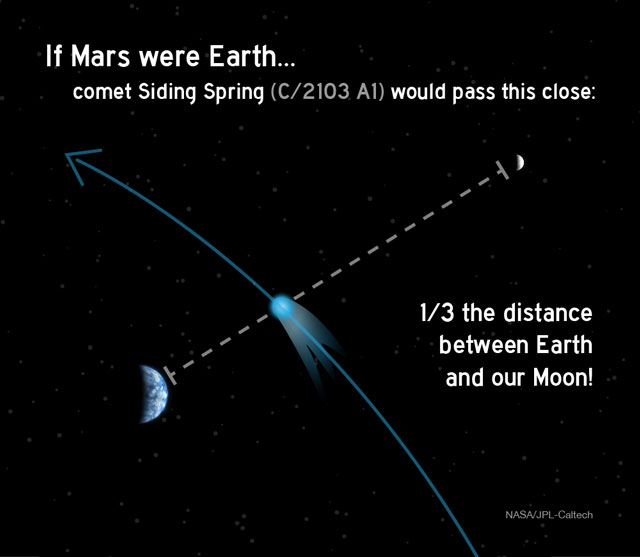Mars spacecraft preparing for Comet Siding Spring’s close flyby

As Comet C/2013 A1 Siding Spring heads toward a close flyby of Mars on October 19, 2014, NASA and ESA are both taking steps to protect their Mars orbiters, while still preserving opportunities to gather valuable scientific data. Six days after passing Mars, the comet will reach its closest approach to the Sun (perihelion) at about 209 million km (130 million miles).
It will be the second comet to visit Mars in 12 months, following Comet ISON in October 2013. ISON passed some 10 000 000 km from the planet, but Siding Spring will flyby much closer. Current estimates put Siding Spring's miss distance at just about 132 000 km (82 000 miles) from the surface.
The comet's nucleus will be shedding material hurtling at about 56 kilometers (35 miles) per second, relative to Mars and Mars-orbiting spacecraft. At that velocity, even the smallest particle – estimated to be about half a millimeter (one-fiftieth of an inch) across – could cause significant damage to a spacecraft.

Animation courtesy of the Near-Earth Object (NEO) office at NASA's JPL

Image credit: NASA/JPL-Caltech
NASA currently operates two Mars orbiters, with a third on its way and expected to arrive in Martian orbit just a month before the comet flyby. ESA has one spacecraft there, Mars Express. India's Mars Orbiter Mission launched late 2013 is also on the way and will arrive about three weeks before Siding Spring.
Teams operating the orbiters plan to have spacecraft positioned on the opposite side of the Red Planet when the comet is most likely to pass by.
The hazard is not an impact of the comet nucleus, but the trail of debris coming from it. Using constraints provided by Earth-based observations, the modeling results indicate that the hazard is not as great as first anticipated. Mars will be right at the edge of the debris cloud, so it might encounter some of the particles — or it might not. – Rich Zurek, chief scientist for the Mars Exploration Program at NASA's Jet Propulsion Laboratory in Pasadena, California.

Image credit: NASA/JPL
During the day's events, the smallest distance between Siding Spring's nucleus and Mars will be less than one-tenth the distance of any known previous Earthly comet flyby. The period of greatest risk to orbiting spacecraft will start about 90 minutes later and last about 20 minutes, when Mars will come closest to the center of the widening dust trail from the nucleus.
NASA's Mars Reconnaissance Orbiter (MRO) made one orbit-adjustment maneuver on July 2 as part of the process of repositioning the spacecraft for the October 19th event. An additional maneuver is planned for August 27. The team operating NASA's Mars Odyssey orbiter is planning a similar maneuver on August 5 to put that spacecraft on track to be in the right place at the right time, as well.
NASA's Mars Atmosphere and Volatile Evolution (MAVEN) spacecraft is on its way to the Red Planet and will enter orbit on September 21. The MAVEN team is planning to conduct a precautionary maneuver on October 9, prior to the start of the mission's main science phase in early November.
In the days before and after the comet's flyby, NASA will study the comet by taking advantage of how close it comes to Mars. Researchers plan to use several instruments on the Mars orbiters to study the nucleus, the coma surrounding the nucleus, and the tail of Siding Spring, as well as the possible effects on the Martian atmosphere. This particular comet has never before entered the inner solar system, so it will provide a fresh source of clues to our solar system's earliest days.
MAVEN will study gases coming off the comet's nucleus into its coma as it is warmed by the sun. MAVEN also will look for effects the comet flyby may have on the planet's upper atmosphere and observe the comet as it travels through the solar wind.
Odyssey will study thermal and spectral properties of the comet's coma and tail. MRO will monitor Mars' atmosphere for possible temperature increases and cloud formation, as well as changes in electron density at high altitudes. The MRO team also plans to study gases in the comet's coma. Along with other MRO observations, the team anticipates this event will yield detailed views of the comet's nucleus and potentially reveal its rotation rate and surface features.
Mars' atmosphere, though much thinner than Earth's, is thick enough that NASA does not anticipate any hazard to the Opportunity and Curiosity rovers on the planet's surface, even if dust particles from the comet hit the atmosphere and form into meteors. Rover cameras may be used to observe the comet before the flyby, and to monitor the atmosphere for meteors while the comet's dust trail is closest to the planet.
Viewing from Earth
Although Mars spacecraft will have front row seat, views from Earth are also possible. Depending on the size and brightness of comet, viewers in the Southern Hemisphere can potentially see it with binoculars and telescopes beginning in September, 2014. From Earth, Comet Siding Spring will appear in the constellation Ophiochus and visible low in the southwestern sky at dusk.
Siding Spring by the numbers
- Date of comet closest approach (CA): 19 October 19, 2014
- Time of CA: ~18:28 UTC
- *Estimated distance of comet from Mars at CA: 136 000 km from center | 132 000 km from surface
- Comet nucleus diameter: Unknown
- Coma radius: Likely to engulf Mars
- Time for Mars to pass through coma: Several hours (ESA's Mars Express now orbits Mars every 7 hours)
- Velocity of cometary dust particles: 56 km/second
- Dust particles produced by comet (as of 28/1/14): 100 kg/second
Sources: ESA, NASA/JPL-Caltech
Featured image: NASA

Considering that, the pressure of dust particles from C/2013A1 will be dangerous to spacecraft’s, what are some structural design elements that a spacecraft needs so that it can survive the duration of its mission.